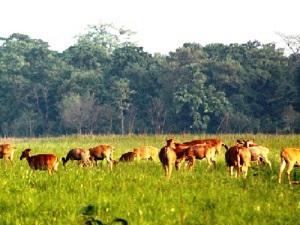Hemanta Kumar Yadav
Other projects
16 Nov 2015
Ecology and Conservation of Swamp Deer (Recervus duvaucelii duvaucelii) in Shuklaphanta Wildlife Reserve, Nepal
The project aims at understanding the ecology of swamp deer (Cervus duvauceli duvauceli) with emphasis on seasonal group structure, population structure, seasonal movement, nutrition ecology and its interaction with other sympatric ungulates and predators (tiger and leopard).

The researcher with assistants collecting data on swamp deer.
Five species of deer such as swamp deer, hog deer, barking deer, samber and spotted deer occur sympatrically in Shuklaphanta Wildlife Reserve (SWR). Swamp deer or Barasingha, endemic to Indian subcontinent, once widely distributed across North Indian Gangetic plain and its extension are now confined to only some small isolated pockets in Nepal and India. The viable population exists in some protected areas of India and SWR holds the largest population in its distribution range. The ecological study of Barasingha in Nepal is very scanty except studies in 1770s and 1990s (Schaaf, 1978; Hensew, 1994).

Herd of swamp deer.
Based on the recommendations by Schaaf (1978), the proposed study aims to study the seasonal dynamics of group structure and population status of Barasingha. Other ecological attributes this study aims are seasonal nutritional ecology (food preference and nutrient contents in the feeding plants), ranging behavior along with investigation of competition among them for food and space. As ungulates contribute the major food for the carnivores specifically for tiger and leopard, this study also attempts to gain an understanding of predation pressure. The output of the study will be used as materials for education in schools and community for raising awareness ensuring long term survival of this protected species.